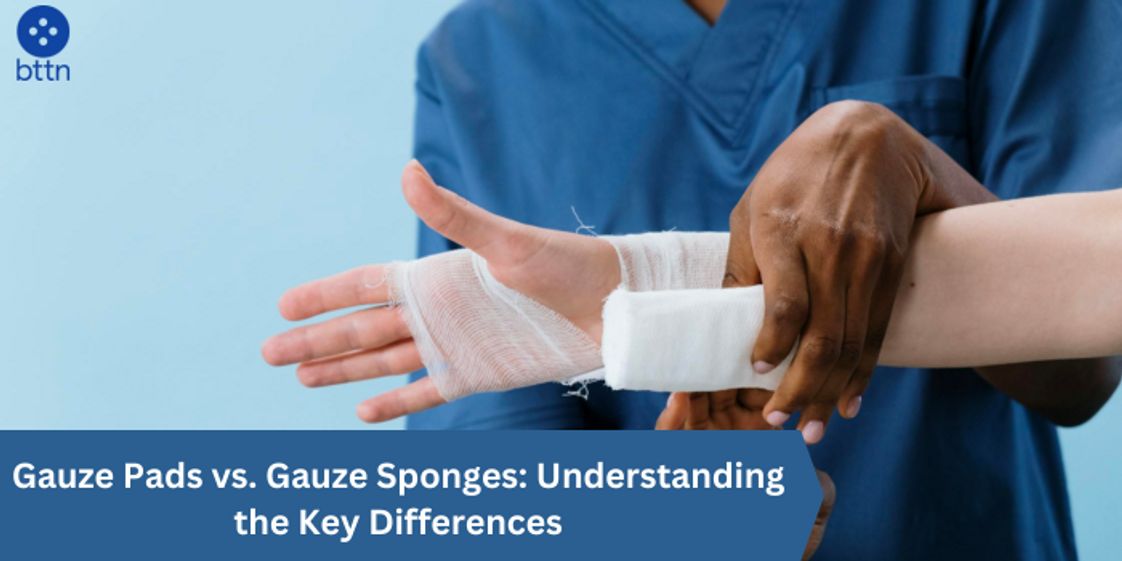
Gauze Pads vs. Gauze Sponges: Understanding the Key Differences
Posted by Pankaj Dhiman on Nov 27th 2023
Gauze Pads vs. Gauze Sponges: Choosing the Right Wound Care for Every Situation
Gauze pads and gauze sponges are two common medical supplies that are often used for wound care. They are both made of gauze, a type of thin, absorbent fabric. However, there are some key differences between the two products.
Shop Now: Gauze Pads
What are Gauze Pads?
Gauze pads are flat, square or rectangular pieces of gauze that are typically packaged individually. They are used to absorb blood and other fluids from minor wounds, such as cuts, scrapes, and burns. Gauze pads can also be used to apply pressure to stop bleeding. They are soft and comfortable to wear, and they will not irritate the skin.
- Cleaning wounds
- Applying antibiotic ointment
- Absorbing blood and other fluids
- Protecting wounds from infection
What are Gauze Sponges?
Gauze sponges are larger, more absorbent pieces of gauze that are typically packaged in sterile pouches. They are used for heavier bleeding or for packing wounds that are deep or hard to reach. Gauze sponges are also used in surgical procedures to absorb blood and other fluids. They are more bulky than gauze pads, but they are still soft and comfortable to wear.
- Packing wounds
- Controlling bleeding
- Absorbing large amounts of fluids
- Cleaning surgical sites
Uses of Gauze Pads and Gauze Sponges
Gauze pads and gauze sponges are both used for a variety of purposes, including:
- Cleaning wounds
- Applying antibiotic ointment
- Absorbing blood and other fluids
- Protecting wounds from infection
- Packing wounds
- Controlling bleeding
- Absorbing large amounts of fluids
- Cleaning surgical sites
Shop Now: Dukal Non Adherent Pads
Convenience vs. Coverage
While gauze pads boast convenience, especially in their individually wrapped form, gauze sponges prioritize coverage. The choice between the two often boils down to the specific requirements of the wound and the preferences of the person administering the care.
For on-the-go first aid, gauze pads shine. They are easily portable, and their single-use packaging ensures cleanliness. Gauze sponges, however, are better suited for planned wound care scenarios where a larger dressing is needed.
Must Read: Buy Irrigation Tray, Bottle, Syringes and Supplies - Wound Irrigation
Cost Considerations
In the world of healthcare, costs are always a factor. Gauze pads are generally more cost-effective, making them an economical choice for everyday use. For individuals and families looking to stock up on first aid essentials without breaking the bank, gauze pads are the budget-friendly option.
Gauze sponges, with their enhanced features and larger size, come with a slightly higher price tag. However, when the situation demands their specific attributes, the investment is justified for the benefits they bring to more complex wound care scenarios.
When to Use Which
Now that we've dissected the characteristics of gauze pads and gauze sponges, it's crucial to understand when to use each.
Gauze Pads:
- Minor cuts and abrasions
- Everyday first aid scenarios
- Smaller wounds with minimal drainage
Gauze Sponges:
- Post-surgical wounds
- Wounds with moderate to heavy drainage
- Injuries requiring extensive coverage
The table below summarizes the key differences between gauze pads and gauze sponges.
| Feature | Gauze Pads | Gauze Sponges |
|---|---|---|
| Size | Small | Large |
| Shape | Flat, square or rectangular | Irregular |
| Absorption | Low | High |
| Packaging | Individual | Sterile pouches |
| Uses | Minor wounds, applying pressure to stop bleeding | Heavier bleeding, packing wounds |
FAQs
Q. What is the difference between sterile and non-sterile gauze pads?
A. Sterile gauze pads are packaged in a way that ensures they are free of bacteria and other contaminants. Non-sterile gauze pads are not packaged in a sterile environment. Sterile gauze pads should be used for wounds that are at risk of infection, such as surgical incisions. Non-sterile gauze pads can be used for minor wounds that are not at risk of infection.
Q. Can I reuse gauze pads?
A. No, gauze pads should not be reused. They are designed for single-use only. Reusing gauze pads can increase the risk of infection.
Q. How should I store gauze pads?
A. Gauze pads should be stored in a cool, dry place. They should not be exposed to moisture or direct sunlight.
Q. How do I dispose of gauze pads?
A. Gauze pads should be disposed of in a trash can. They should not be flushed down the toilet.
Conclusion
Gauze pads and gauze sponges are both essential medical supplies that can be used to treat a variety of wounds. The best product for you will depend on the severity of your injury. If you have any questions about which product to use, consult with your doctor.
